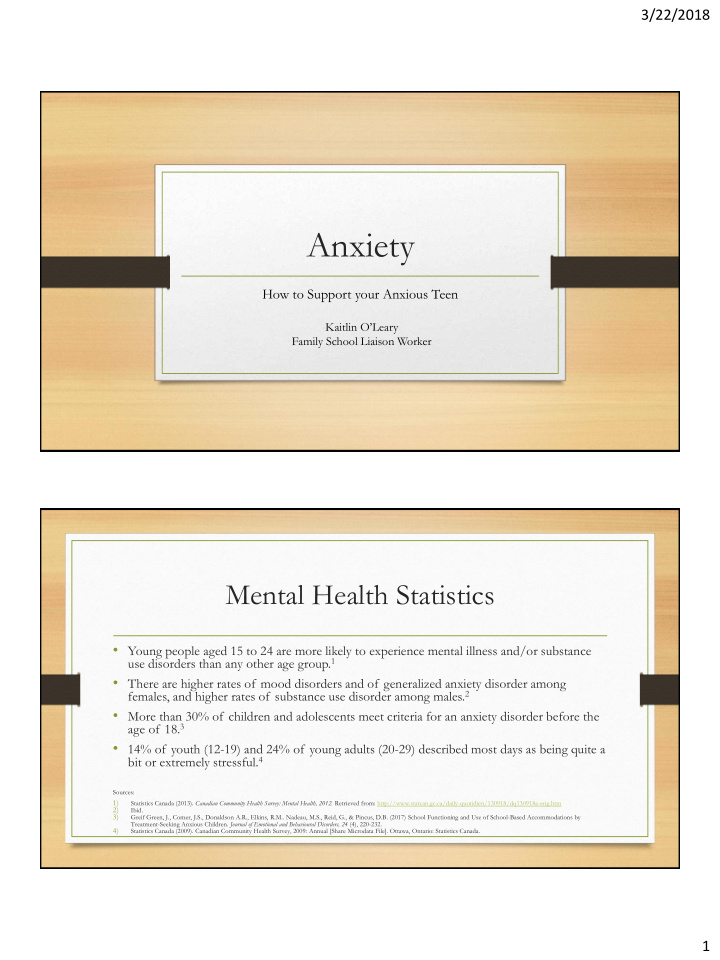



3/22/2018 Anxiety How to Support your Anxious Teen Kaitlin O’Leary Family School Liaison Worker Mental Health Statistics • Young people aged 15 to 24 are more likely to experience mental illness and/or substance use disorders than any other age group. 1 • There are higher rates of mood disorders and of generalized anxiety disorder among females, and higher rates of substance use disorder among males. 2 • More than 30% of children and adolescents meet criteria for an anxiety disorder before the age of 18. 3 • 14% of youth (12-19) and 24% of young adults (20-29) described most days as being quite a bit or extremely stressful. 4 Sources: 1) Statistics Canada (2013). Canadian Community Health Survey: Mental Health, 2012. Retrieved from: http://www.statcan.gc.ca/daily-quotidien/130918/dq130918a-eng.htm 2) Ibid. 3) Greif Green, J., Comer, J.S., Donaldson A.R., Elkins, R.M.. Nadeau, M.S., Reid, G., & Pincus, D.B. (2017) School Functioning and Use of School-Based Accommodations by Treatment-Seeking Anxious Children . Journal of Emotional and Behavioural Disorders, 24 (4), 220-232. 4) Statistics Canada (2009). Canadian Community Health Survey, 2009: Annual [Share Microdata File]. Ottawa, Ontario: Statistics Canada. 1
3/22/2018 Biggest Concerns at HTA Issues Affecting Students at HTA 80 70 60 50 40 30 20 10 0 Stress Anxiety Depression Drugs and Alcohol Relationships Friendships Self-Esteem Body Image Social Exclusion Bullying Percentage The Good News • Anxiety helps people to be on their toes in dangerous situations. • Anxiety is considered one of the most treatable mental health concerns. • Anxiety doesn’t stay high forever: at some point, it will always come back down. • Everyone experiences anxiety! 2
3/22/2018 Teenage Emotions Per Minute… Is my child irritable because of anxiety? Normal Teenage Irritability Anxious Irritability • Periodic frustrations with daily stressors • Appears upset over very small things • Occasional moodiness but still has a sense • Acts irritable for frequent and long of humour periods of time • Sometimes wants to be alone • Easily overwhelmed during social • Occasionally sarcastic or snappy interactions • Still appears content and joyful on many • Frequently snaps at others occasions • Often appears tense and nervous 3
3/22/2018 Anxious Feelings vs Anxiety Disorder It may be concerning if your child… • Is prickly every time you try to interact with them • Worry occurs more often than not for at least 6 months and is clearly excessive • Experiences frequent panic attacks, vomiting, and/or muscle tension • Refuses to do things or go places • Is rigid, inflexible, and self-critical • Has difficulty sleeping and tires easily What do I do if my kid is anxious? 4
3/22/2018 Common Patterns • Reassuring and overprotecting • Identifying your child as anxious or a worrier because it runs in the family • Giving too much information in order to reassure eg. Running through how the day will look, letting child know your daily schedule, etc. • Allowing negative behaviours because of ‘the anxiety’ • Modeling your own anxious behavior • Pushing too hard and/or becoming angry Source: Wilson, R. & Lyons, L. (2013). Anxious Kids, Anxious Parents. Deerfield Beach, FL: Health Communications Inc. Avoidance • Produces a major feeling of relief, becomes easy to get stuck in this rut • Flawed beliefs never get tested as untrue • Avoidance worsens fears by never teaching a person that they actually can handle the situation they are trying to avoid • Confronting fears is a better strategy for feeling less afraid 5
3/22/2018 IT’S NORMAL AND HEALTHY TO FEEL SAD, GUILTY, ANXIOUS, FRUSTRATED, DISAPPOINTED AND ANGRY. Talk back to anxiety! 6
3/22/2018 Exposing teens to uncertain situations Examples of Safety Behaviours: • Checking over and over whether something is safe • Engaging in too much distraction or coping mechanisms when confronting a feared situation (eg. Listening to music, snapping elastic) • Asking for reassurance • Staying too close to someone/something considered safe Example of Gradual Exposure Source: Schab, L.M. (2008). Anxiety Workbook for Teens . USA: New Harbinger Publications, Inc. 7
3/22/2018 Increasing Motivation for Change • How has anxiety gotten in the way of doing things they want to do? • How will life be more enjoyable once fears have been faced? • How might you behave differently if you were able to feel less anxious? • What would be fun to try if you never felt anxious? Accommodations Reasonable Unreasonable • Double time for tests when first • Unlimited time to complete tests diagnosed with an anxiety disorder • Isolation for quizzes, tests and • Smaller room for tests and exams exams following diagnosis • Taking three or more breaks or • Taking short 5 minute breaks once or twice during class when anxious breaks longer then 5-7 minutes feelings arise 8
3/22/2018 To be a good coach You must be able to: • Be patient with setbacks or slow progress • Tolerate seeing your child visibly distressed • Resist checking in to make sure teen is okay and resist reassuring • Be optimistic Know How to Calm Down 9
3/22/2018 In Summary • Expect worry to show up and normalize it • Encourage your child to externalize and talk to their worry • Support your child to be willing to feel unsure and uncomfortable in stressful situations • Help your child gain strategies for calming themselves down Other Resources Books: • Helping Your Anxious Teen by Sheila Achar Josephs • Anxious Kids, Anxious Parents by Reid Wilson and Lynn Lyons Website: • https://www.anxietybc.com/ Apps: • Breathe2Relax • Stop, Breathe, & Think • Mindshift 10
3/22/2018 Questions? 11
Recommend
More recommend